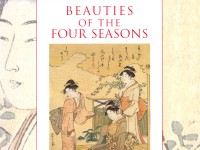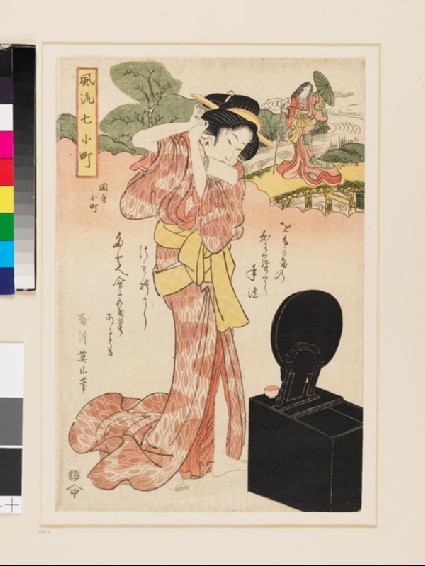Beauties of the Four Seasons
A full catalogue of the Ashmolean’s collection of Japanese bijinga (beautiful women) prints by Mitsuko Watanabe (published Oxford, 2005).

Publications online: 54 objects
Komachi of the Sekidera Temple
-
Literature notes
Here a woman, as a mitate of Sekidera-komachi, is standing and dressing her hair in front of a mirror, suggesting the passing years. She wears a thin casual kimono indicative of summer. Behind, in a cartouche, the now old Komachi who lives near the Sekidera (temple) is crossing a bridge holding an umbrella and a walking stick. -
Details
- Series
- Seven Fashionable Figures of Ono no Komachi
- Associated place
- Date
- c. 1805 - 1820
- Artist/maker
-
Kikukawa Eizan (1787 - 1867) (designer)Ono no Komachi (c. AD 825 – c. 900) (author)
- Associated people
-
Koyama Hangorō (active c. 1805 - 1820) (publisher)Ono no Komachi (c. AD 825 – c. 900) (subject)
- Material and technique
- nishiki-e (multi-block) woodblock print, printed with water-based vegetable pigments
- Dimensions
-
mount 55.5 x 40.7 cm (height x width)
print 37.7 x 25.5 cm (height x width)
- Material index
- Technique index
- Object type index
- No. of items
- 1
- Credit line
- Presented by Mrs Allan and Mr and Mrs H. N. Spalding, 1952.
- Accession no.
- EAX.4437
-
Further reading
Oxford: Ashmolean Museum, 24 August-30 November 2005, Beauties of the Four Seasons, Mitsuko Watanabe, ed. (Oxford: Ashmolean Museum, 2005), no. 32 on p. 68, p. 62, illus. p. 69
Glossary (4)
mitate, mitate-e, nishiki-e, vegetable pigments
-
mitate
Mitate, or riddle, is a form of visual and literary parody on a classical theme. It required prior knowledge in order to decipher it.
-
mitate-e
Mitate-e, or riddle, is a form of visual and literary parody on a classical theme. It required prior knowledge in order to decipher it.
-
nishiki-e
Nishiki-e literally means 'brocade pictures' and refers to multi-coloured woodblock prints.
-
vegetable pigments
Vegetable pigments were used to create coloured dyes for Japanese prints, paintings, and textiles. These pigments often faded over time due to the chemical reactions they underwent.
Location
-
- currently in research collection
Objects are sometimes moved to a different location. Our object location data is usually updated on a monthly basis. Contact the Jameel Study Centre if you are planning to visit the museum to see a particular object on display, or would like to arrange an appointment to see an object in our reserve collections.
Publications online
-

Beauties of the Four Seasons
Here a woman, as a mitate of Sekidera-komachi, is standing and dressing her hair in front of a mirror, suggesting the passing years. She wears a thin casual kimono indicative of summer. Behind, in a cartouche, the now old Komachi who lives near the Sekidera (temple) is crossing a bridge holding an umbrella and a walking stick.
Notice
Object information may not accurately reflect the actual contents of the original publication, since our online objects contain current information held in our collections database. Click on 'buy this publication' to purchase printed versions of our online publications, where available, or contact the Jameel Study Centre to arrange access to books on our collections that are now out of print.
© 2013 University of Oxford - Ashmolean Museum

